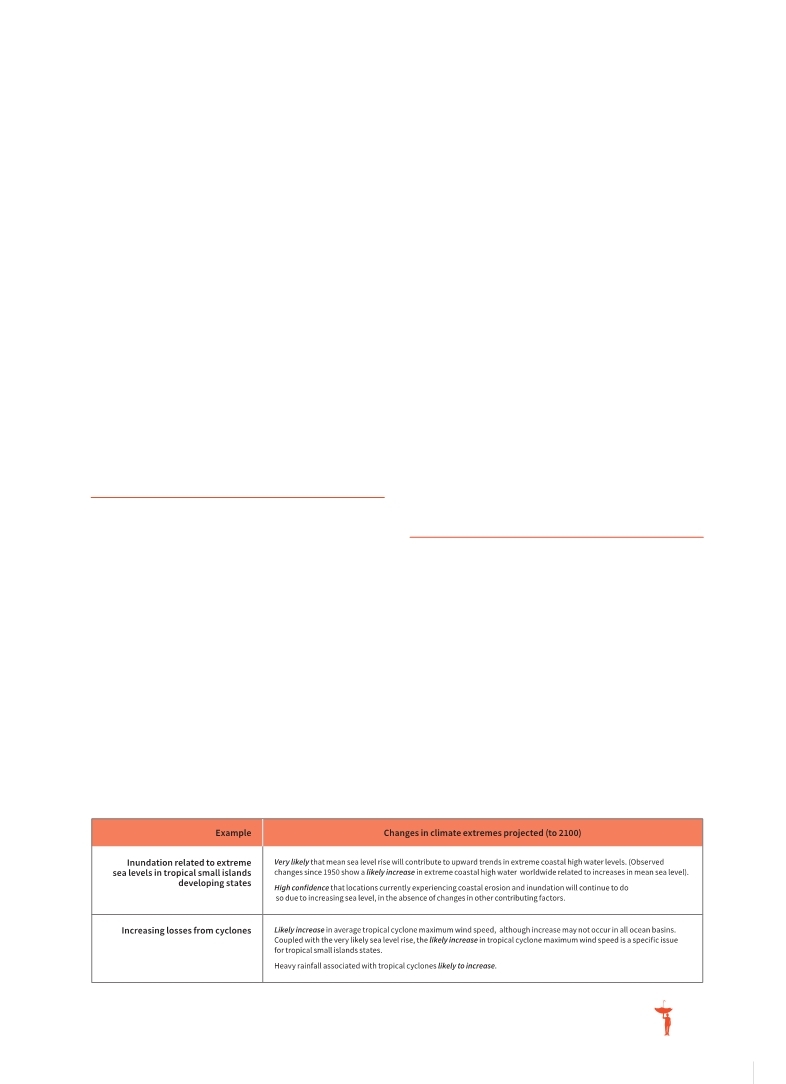 |
Global Assessment Report on Disaster Risk Reduction 2013
From Shared Risk to Shared Value: the Business Case for Disaster Risk Reduction |
 |
Global Assessment Report on Disaster Risk Reduction 2013
From Shared Risk to Shared Value: the Business Case for Disaster Risk Reduction |
|
|


|

109
Table 7.2 Projected changes in climate extremes for SIDS
floods are often associated with the accumulation of rainfall in low-lying areas.
Table 7.1 highlights AAL associated with ponding flooding for six Caribbean countries. Barbados has the highest proportion of its urban produced capital at risk, followed by Puerto Rico. In most countries, wind damage represents a more significant risk than ponding floods. However, in Barbados, the AAL of ponding floods is higher than that of wind damage. This type of flooding is particularly disruptive because it can last for several days, interrupting transport and posing health risks. Thus, although direct losses might be low compared with other hazards, indirect losses for local households and businesses might be significant.
7.2
Climate change impacts on
SIDS
SIDS are among the countries that contribute least to climate change yet stand to suffer most from its negative impacts. Disaster losses are projected to increase, due to sea level rise, the increased severity of cyclones worsening water scarcity and drought and other factors.
SIDS contribute less than 1 percent of total carbon dioxide emissions. v But given their high exposure to weather-related hazards, they are likely to disproportionately suffer from the magnifying effect of climate change. These effects include sea level rise and associated flood and storm surge hazard, in-
creasing cyclonic wind intensity, erosion, saltwater intrusion into coastal aquifers and worsening water scarcity and drought (CCRIF, 2010
CCRIF (The Caribbean Catastrophe Risk Insurance Facility). 2010.,Enhancing the climate risk and adaptation fact base for the Caribbean: Preliminary results of the ECA Study., CCRIF's Economics of Climate Adaptation (ECA) Initiative., Grand Cayman,Cayman Islands.. . Perch-Nielsen, S. L. 2009.,The vulnerability of beach tourism to climate change. An index approach., Climatic Change (2010) 100:579–606.. . UNEP (United Nations Environment Programme). 2008.,Coastal Degradation Leaves the Caribbean in Troubled Waters., Environment Alert Bulletin 11. February 2008. UNEP-DEWA / GRID-Europe., Geneva,Switzerland.. . IPCC (Intergovernmental Panel on Climate Change). 2012.,Managing the Risks of Extreme Events and Disasters to Advance Climate Change Adaptation., Special Report of Working Groups I and II of the Intergovernemental Panel on Climate Change (Field, C.B., V.Barros, T.F.Stocker, D.Qin, D.J.Dken, K.L.Ebi, M.D. Mastrandrea, K.J. Mach, G.-K. Plattner, S.K. Allen, M. Tignor, and P.M. Midgley (eds.). Cambrid, Cambridge, UK, and New York, NY, USA.,. . Simpson, M.C., Gössling, S., Scott, D., Hall, C.M. and Gladin, E. 2008.,Climate Change Adaptation and Mitigation in the Tourism Sector: Frameworks, Tools and Practices., UNEP, University of Oxford, UNWTO, WMO., Paris,France.. . For example, SIDS located in the Pacific can expect to experience extreme events such as storm surges, heavy rainfall, tropical cyclones, droughts and heat waves with significant negative impacts (Australian Bureau of Meteorology and CSIRO, 2011). In the Caribbean, changes in annual hurricane frequency and intensity could result in additional annual losses of US$446 million by 2080—incurred mainly from business interruption to the tourism sector (Toba, 2009
Toba, N. 2009.,Potential Economic Impacts of Climate Change in the Caribbean Community., Latin America and Caribbean Region Sustainable Development Working paper 32, "Assessing the Potential Consequences of Climate Destabilization in Latin America". World Bank., Washington DC.,USA.. . Table 7.2 highlights likely climate change impacts on SIDS identified by the IPCC (2012).
7.3
Disaster losses and economic
resilience
As a result of limited diversification and small market size, the economies of many SIDS are not resilient to disaster loss. Both estimated and observed losses represent a high proportion of annual capital formation and contribute to sluggish longer-term growth.
Disaster risks pose a serious threat to SIDS economies. Figure 7.4 shows that in the case of catastrophic earthquakes with a 250 year return period, 10 out of the 13 countries where losses would be greater
(Source: adapted from
 Mahon et al., 2012 Mahon et al., 2012 Mahon, R., Backen, S. and Rennie, H. 2012.,Evaluating the Business Case for Investment in the Risk Resilience of the Tourism sector of Small Island Developing States., Background Paper prepared for the 2013 Global Assessment Report on Disaster Risk Reduction., Geneva,Switzerland: UNISDR.. Mahon, R., Backen, S. and Rennie, H. 2012.,Evaluating the Business Case for Investment in the Risk Resilience of the Tourism sector of Small Island Developing States., Background Paper prepared for the 2013 Global Assessment Report on Disaster Risk Reduction., Geneva,Switzerland: UNISDR.. Click here to view this GAR paper. IPCC (Intergovernmental Panel on Climate Change). 2012.,Managing the Risks of Extreme Events and Disasters to Advance Climate Change Adaptation., Special Report of Working Groups I and II of the Intergovernemental Panel on Climate Change (Field, C.B., V.Barros, T.F.Stocker, D.Qin, D.J.Dken, K.L.Ebi, M.D. Mastrandrea, K.J. Mach, G.-K. Plattner, S.K. Allen, M. Tignor, and P.M. Midgley (eds.). Cambrid, Cambridge, UK, and New York, NY, USA.,. . |



 |
